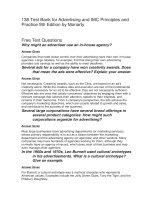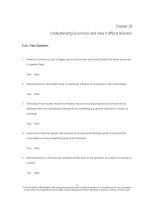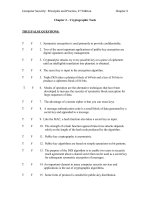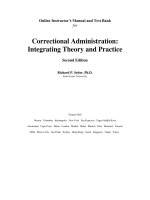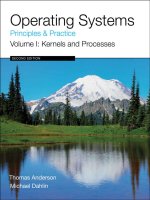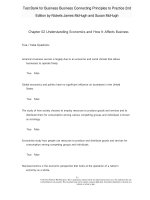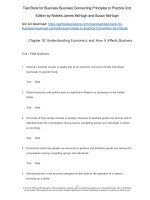Sustainability principles and practice 2nd edition
Bạn đang xem bản rút gọn của tài liệu. Xem và tải ngay bản đầy đủ của tài liệu tại đây (3.28 MB, 489 trang )
p.i
Sustainability Principles and Practice
This new and expanded edition builds upon the first edition’s accessible and comprehensive
overview of the interdisciplinary field of sustainability. The focus is on furnishing solutions and
equipping the student with both conceptual understanding and technical skills for the workplace.
Each chapter explores one aspect of the field, first introducing concepts and presenting issues, then
supplying tools for working toward solutions. Techniques for management and measurement as well
as case studies from around the world are provided. The second edition includes a complete update
of the text, with increased coverage of major topics including the Anthropocene; complexity;
resilience; environmental ethics; governance; the IPCC’s latest findings on climate change;
Sustainable Development Goals; and new thinking on native species and novel ecosystems.
Chapters include further reading and discussion questions. The book is supported by a companion
website with links, detailed reading lists, glossary, and additional case studies, together with
projects, research problems, and group activities, all of which focus on real-world problem solving
of sustainability issues.
The textbook is designed to be used by undergraduate college and university students in
sustainability degree programs and other programs in which sustainability is taught.
Margaret Robertson is a member of the American Society of Landscape Architects (ASLA) and
teaches at Lane Community College in Eugene, Oregon, USA, where she coordinates the
Sustainability degree program.
p.iii
Sustainability Principles
and Practice
Second Edition
Margaret Robertson
p.iv
Second edition published 2017
by Routledge
2 Park Square, Milton Park, Abingdon, Oxon, OX14 4RN
and by Routledge
711 Third Avenue, New York, NY 10017
Routledge is an imprint of the Taylor & Francis Group, an informa business
© 2017 Margaret Robertson
The right of Margaret Robertson to be identified as author of this work has been asserted by her in accordance with sections 77 and 78
of the Copyright, Designs and Patents Act 1988.
All rights reserved. No part of this book may be reprinted or reproduced or utilized in any form or by any electronic, mechanical, or other
means, now known or hereafter invented, including photocopying and recording, or in any information storage or retrieval system, without
permission in writing from the publishers.
First edition published by Routledge 2014
British Library Cataloguing in Publication Data
A catalogue record for this book is available from the British Library
Library of Congress Cataloging-in-Publication Data
Names: Robertson, Margaret, author.
Title: Sustainability principles and practice / Margaret Robertson.
Description: Abingdon, Oxon ; New York, NY : Routledge, 2017. | Earlier edition: 2014. | Includes bibliographical references and index.
Identifiers: LCCN 2016036622| ISBN 9781138650213 (hbk) | ISBN 9781138650244 (pbk) | ISBN 9781315625478 (ebk)
Subjects: LCSH: Sustainability. | Sustainable development. | Environmental economics.
Classification: LCC HC79.E5 R6243 2017 | DDC 338.9/27—dc23
LC record available at />ISBN: 978-1-138-65021-3 (hbk)
ISBN: 978-1-138-65024-4 (pbk)
ISBN: 978-1-315-62547-8 (ebk)
Typeset in Times New Roman
by Swales & Willis Ltd, Exeter, Devon
Visit the companion website: />
p.v
“The great strength of Robertson’s book is its breadth of coverage. From marketing to life cycle costing to the latest science on
climate change, Sustainability Principles and Practice serves as a welcoming guide into the often jargon-laden field of
sustainability.”
—Jay Antle, Johnson County Community College, USA
“This book is a solid and well-crafted introduction to the field, conveying both the substance and the heart of sustainability work with
style and grace. It will help students and other new entrants to the field get oriented to the special interdisciplinary challenges of
sustainability, and to its core mission: helping us learn to be better caretakers of our planetary future.”
—Alan AtKisson, President & CEO AtKisson Inc., USA & AtKisson Europe AB, Sweden. President, ISIS Academy GmbH,
Germany. Member, President’s Science and Technology Advisory Council (PSTAC), European Commission
“This is an important book. Robertson has a keen sense of the situation and an even keener sense of alternatives and means to
achieve them. The author gives it to you the way it is and then provides some important pointers to resilient futures. This book contains
both a diagnosis and a treatment. Read it.”
—Simon Bell, Open University, UK
“An organized, engaging, and even inspiring collection of ideas that—if internalized and used to inform policies—would enable
societies to thrive within a healthy environment. I wish this book had been available when I was first learning about social and
environmental systems.”
—Robert Dietz, Editor, The Daly News, Center for the Advancement of the Steady State Economy
“A comprehensive and practical map of the evolving field of sustainability. This well-organized and thoroughly researched textbook
provides both students and educators with a useful guide to the essential sustainability topics. Robertson delivers an important work
that will help to define the knowledge base in the sustainability field.”
—Andrés R. Edwards, Founder, EduTracks, USA. Author of The Sustainability Revolution and Thriving Beyond Sustainability
“Robertson places sustainability in the connectedness between human culture and the living world. She links technical knowledge with
tools for developing positive solutions and putting them into effect, including working collaboratively in organizations with other people.”
—Bruce K. Ferguson, University of Georgia, USA
“Robertson has distilled the essential background information that students, our rising decision-makers, need so that they can follow her
clearly defined roadmap to a sustainable future for the planet.”
—Lee Kump, Pennsylvania State University, USA
“Sustainability Principles and Practice covers a broad range of topics, principles and concepts—at several scales from energy,
water, pollution, ecosystems, food, and cities—to a charge to future ‘agents for change’ at policy, institutional, and personal,
experiential levels. A must-have book to refresh your knowledge and to make a better world.”
—Alison Kwok, University of Oregon, USA
p.vi
“From now on when someone asks me what is sustainability, I will tell them to read Margaret Robertson’s book, Sustainability
Principles and Practice, which presents clearly and thoroughly the multi-faceted concept of sustainability in a very readable form.”
—Norbert Lechner, Auburn University, USA
“Everyone thinks they know what sustainability is, but few people truly understand it—and fewer still can explain it well. Robertson
cuts through the greenwash and the clichés with a top-notch exploration of the topic in all its complexities. It’s an enjoyable read that’s
both thoroughly grounded in science and steeped in wonder at our fascinating, fragile planet.”
—Daniel Lerch, Post Carbon Institute, USA
“Robertson’s incisive analysis is both global and specific, comprehensive and inclusive. There is careful blending of facts and values,
what is and what ought to be. You will find yourself engaged. I guarantee it.”
—Holmes Rolston, III, Colorado State University, USA
“This book grabbed my attention and kept me engaged. The focus on creating solutions is refreshing. This publication will enhance and
deepen the work of any general reader, student or faculty member working to bring sustainability into the curricula.”
—Debra Rowe, Oakland Community College, USA
“This book masterfully integrates human and natural systems and the relationships between them into a grand and detailed picture of
the world we live in. It provides a highly accessible introduction to sustainability suitable for anyone who cares about where we are
going as a species, translating this knowledge into practical action.”
—Arran Stibbe, University of Gloucestershire, UK
“This is a comprehensive, useful account of what sustainability is all about and what is needed for building it. It describes the many
facets that collectively determine the degree to which a system, at any scale, is sustainable, and explains how they interact. It is a
valuable guide and reference for anyone wishing to get involved in the practice of sustainability.”
—Brian Walker, CSIRO Ecosystem Sciences, Australia. Author of Resilience Thinking
“Sustainability champions practice systems thinking, connecting the dots between green buildings, sustainable cities, corporate CSR,
and all the global sustainability megaforces besieging us. This book is their indispensable primer and wonderfully practical handbook to
ensure they are effective change agents. It is a coherent encyclopedia of sustainability issues, with answers.”
—Bob Willard, Sustainability Advantage, Canada
p.vii
Contents
List of Illustrations
Supplementary Material
List of Abbreviations
PART I
Context
1 What Is Sustainability?
What Is Sustainability?
Sustainability and Resilience
Systems Thinking
Living in the Anthropocene
2 A Brief History of Sustainability
Recent History: The Last 200 Years
Early Conservation
Transformation from Conservation to Ecology
The Beginnings of the Environmental Movement
US Legislation in the 1970s
Environmental Justice
Environmental Ethics
Expanding to a Global Scale
Modern Trends
Into the Anthropocene
3 The Biosphere
Why Study Living Systems?
Energy and Matter
The Four Spheres
The Biosphere
What Is Life?
Earth System Science
p.viii
4 The Human Sphere
Human Impact
Economics
Failing States
Governance
The Commons
PART II
Issues and Solutions
5 Climate
Is Earth Warming?
How Temperature Records Are Compiled
The Long View: Climates through Time
Modern Climate Change and Greenhouse Gases
The Human Factor
Projecting into the Future
United Nations Convention on Climate Change
Climate Stabilization
Climate Action Plans
Strategies for Reducing Emissions
Offsets
Emissions Trading
Adaptation
Final Thoughts
6 Water
Uneven Distribution
Depletion of Nonrenewable Aquifers
Threats to Human and Ecosystem Health
Consumption
Effects of Climate Change
Water Conservation
Wastewater Treatment
Stormwater
7 Ecosystems and Habitat
Populations and Extinction
Drivers of Ecosystem Change
Conservation and Restoration
Conservation
Restoration Ecology
Living Together: Reconciliation Ecology
Ecology in the Anthropocene
p.ix
8 Pollution
Types of Toxins
Pollution Transport and Fate
Air Pollution
Soil and Land Pollution
Water Pollution
Organic Pollutants
Inorganic Pollutants
Endocrine Disruptors
Persistent Organic Pollutants
Point Source and Nonpoint Source Pollution
Radioactive Pollutants
Pollution Remediation
Pollution Prevention
9 Energy
Fossil Fuels
Renewable Energy
Energy Efficiency
Making the Transition
10 Green Buildings and Sites
What Is a Green Building?
The Process of Green Building Design
Lighting with Daylight
Basics of Heating and Cooling
Heating
Passive Cooling
Other Strategies for Cooling
Ventilation
Building Envelope
Construction
Rating Systems
Aesthetics
Sustainable Sites
Biophilic Design
11 Livable Cities
Sprawl
Land-Use Planning
Urban Planning
Building Community
Transportation
Cities and Climate Change
p.x
12 Food
Farming Methods
Human Health Issues
Planetary Health Issues
Feeding Ourselves
Finding Space for Food in the City
Food on Public Land
Healthy Soil: The Vital Foundation
13 Products
Toward a Circular Economy
Process Design
Product Alternatives
Product Design
Shipping and Packaging
ISO 14000 Standards
Certifications and Labels: Making Sense of Materials
14 Waste and Recycling
Waste Management
Landfills
Incineration
Recycling
Construction & Demolition Waste
Industrial Waste
Zero Waste
PART III
Becoming an Agent for Change
15 Working in an Organization
Governance
Sustainability Professionals at Work
Sustainability Initiatives
The Planning Process
Making the Business Case for Sustainability
Implementation
Frameworks
Measurement and Reporting
Measurement and Reporting Systems
16 Education
Biophilia
Bioregionalism and Place-Based Learning
Learning by Doing: Experiential Learning
The Learning Environment
Stages of Development: Humans as Lifelong Learners
p.xi
17 Working as Agents for Change
Fostering Sustainable Behavior
Efforts Big and Small
Working Together
Social Equity
Building Community
Transition
Bibliography
Index
p.xii
Illustrations
Figures
2.1
4.1
4.2
5.1
5.2
5.3
14.1
Socio-economic and Earth system trends of the Great Acceleration from 1750 to 2010
Arithmetic versus exponential growth
World population since 10,000 BCE
Global average temperature anomalies, 1880–2010
Record of carbon dioxide concentrations measured at the Mauna Loa station, 1958–2010
The global conveyor belt or thermohaline circulation
Municipal solid waste compared with total US solid waste
Boxes
6.1
6.2
7.1
8.1
8.2
9.1
10.1
11.1
11.2
11.3
11.4
12.1
12.2
12.3
12.4
The Aral Sea Disaster
Bottled Water
Reconsidering Invasive Species
Cancer Clusters
Our Stolen Future
Jevons’ Paradox
Natural Cooling Inspired by Termites
The Oberlin Project
Freiburg’s Vauban District
Mole Hill: A Garden in the City
Curitiba, Brazil: Sustainability for All of Us
Bees and Other Pollinators
Polyface Farm
Cuba’s Carbon-Neutral Food System
Food From the ’Hood and the Watts Garden Club
p.xiii
13.1
13.2
13.3
14.1
14.2
14.3
15.1
16.1
16.2
16.3
17.1
17.2
17.3
The Twelve Principles of Green Chemistry
Providing Shelter from the Elements by Reusing Scrap
The ISO 14000 Family of Standards for Environmental Management
The Great Pacific Garbage Patch
Urban Mining
Keep America Beautiful
Scenario Planning
Where You At? A Bioregional Quiz
The STRAW Project
Risky Play and Adventure Playgrounds
Collective Learning: The Deeper Roots of Working in Groups
Consensus in the Applegate Watershed
Sustainable South Bronx
p.xiv
Supplementary Material
Additional resources are available on the Companion Website
/>
for
this
book:
• Throughout the book, defined words are printed in bold the first time they appear. The bold font
signals that a definition of this term can be found in the online glossary on the website.
• A limited number of suggested books for Further Reading are listed at the end of each chapter in
the printed book. A more extensive Further Reading list is available on the Companion Website as
an annotated bibliography with additional books, articles, and links to websites, listed by chapter.
• The printed book provides questions for review and discussion at the end of each chapter.
Additional exercises with end-of-chapter questions, activities, and projects are available on the
Companion Website.
• Case studies and white papers on the Companion Website examine additional topics and specific
skills.
• Educators can find presentation slides to accompany lectures for each chapter on the Companion
Website.
p.xv
Abbreviations
A
ampere (amp)
AASHE
Association for the Advancement of Sustainability in Higher Education
AC
alternating current
APC
American Plastics Council
ASHRAE
American Society of Heating, Refrigerating and Air-Conditioning Engineers
B-2
2 percent biodiesel
B-100
100 percent biodiesel
BAN
Basel Action Network
BART
Bay Area Rapid Transit
BAT
best available technique
bbl
blue barrel
BCE
before common era
Bcf
billion cubic feet
BEV
battery electric vehicle
BHAG
big, hairy, audacious goal
BMP
best management practice
BOD
biochemical oxygen demand
BP
before present
BPA
bisphenol A
BREEAM
Building Research Establishment Environmental Assessment Method
BRT
bus rapid transit
Bt
Bacillus thuringiensis
Btu
British thermal units
C2C
Cradle to Cradle (certification)CM
C&D
construction and demolition
CAFO
concentrated animal feeding operation
CCOF
California Certified Organic Farmers
CCS
carbon capture and sequestration
CE
common era
CERCLA
Comprehensive Environmental Response, Compensation, and Liability Act
CFC
chlorofluorocarbon
CFL
compact fluorescent light
cfm
cubic feet per minute
CH4
methane
CHP
combined heat and power
CII
commercial, institutional, industrial
p.xvi
CO
carbon monoxide
CO2
carbon dioxide
CO2e
carbon dioxide equivalent
COP
Conference of the Parties
COPR
Canada Organic Product Regulation
CPTED
crime prevention through environmental design
CRZ
critical root zone
CSA
community-supported agriculture; Canadian Standards Association
CSD
Commission on Sustainable Development
CVP
Central Valley Project
DC
direct current
DDT
dichloro-diphenyl-trichloroethane
DFD
design for disassembly
DFE
Design for the Environment
DMS
dimethyl sulphide
DNA
deoxyribonucleic acid
DO
dissolved oxygen
DoD
Department of Defense
E10
10 percent ethanol
E85
85 percent ethanol
EC
European Commission
EIA
EMAS
Energy Information Administration
Eco-Management and Audit Scheme
EMS
environmental management system
ENSO
El Niño-Southern Oscillation
EPA
Environmental Protection Agency
EPAct
Energy Policy Act of 1992
EROEI
energy returned on energy invested
ESA
Endangered Species Act
ESCO
energy services company
ESY
Edible Schoolyard
EU
European Union
EUI
energy utilization index
FAO
Food and Agriculture Organization
FDA
Food and Drug Administration
FERC
Federal Energy Regulatory Commission
FFTH
Food From the ’Hood
FLO
Fairtrade International
FSC
Forest Stewardship Council
FWS
Fish and Wildlife Service
GATT
General Agreement on Tariffs and Trade
GBI
Green Building Initiative
GDP
gross domestic product
GM
genetically modified
GMO
genetically modified organism
gpf
gallons per flush
GPI
Genuine Progress Indicator
gpl
gallons per load
gpm
gallons per minute
p.xvii
GPRC
Great Plains Restoration Council
GRAS
Generally Recognized As Safe
GRI
Global Reporting Initiative
GW
gigawatt
GWP
global warming potential
H2O
water
HAP
hazardous air pollutant
HBN
Healthy Building Network
HCP
habitat conservation plan
HDPE
high-density polyethylene
HFC
hydrofluorocarbon
HID
high-intensity discharge
HRS
Hazard Ranking System
HVAC
heating, ventilating and air conditioning
ICI
institutional, commercial, industrial
ICPD
International Conference on Population and Development
IEA
International Energy Agency
IMF
International Monetary Fund
IPBES
Intergovernmental Platform on Biodiversity and Ecosystem Services
IPCC
Intergovernmental Panel on Climate Change
IPM
integrated pest management
IPMVP
International Performance Measurement and Verification Protocol
IPPC
Integrated Pollution Prevention and Control
IPPUC
Urban Planning Institute of Curitiba
ISEW
Index of Sustainable Economic Welfare
ISO
International Organization for Standardization
IUCN
International Union for Conservation of Nature and Natural Resources
KAB
Keep America Beautiful
kW
kilowatt
kWh
kilowatt-hour
LCA
life cycle assessment (or analysis)
LED
light-emitting diode
LEED
Leadership in Energy and Environmental Design
LEED AP LEED
Accredited Professional
LEED GA LEED
Green Associate
LEED-ND LEED
for Neighborhood Development
LID
low-impact development
LTL
M&V
less than a load
measurement and verification
Mcf
thousand cubic feet
MDG
Millennium Development Goal
MHCHS
Mole Hill Community Housing Society
MRF
material recovery facility
MRL
maximum residue limit
MSC
Marine Stewardship Council
MSW
municipal solid waste
MW
megawatt
p.xviii
N2
nitrogen
N2O
nitrous oxide
NAPL
nonaqueous phase liquid
NASA
National Aeronautics and Space Administration
NEPA
National Environmental Policy Act
NGO
nongovernmental organization
NMFS
National Marine Fisheries Service
NO
nitric oxide
NO2
nitrogen dioxide
NOX
nitrogen oxides
NOAA
National Oceanic and Atmospheric Administration
NPL
National Priorities List
NPO
non-product output
NRC
National Recycling Coalition
NREL
National Renewable Energy Laboratory
NSF
National Sanitation Foundation
O2
oxygen
O3
ozone
O&M
operations and maintenance
OECD
Organization for Economic Cooperation and Development
OTEC
ocean thermal energy conversion
OWC
P2
oscillating water column
Pollution prevention
PBT
persistent, bioaccumulative, and toxic
PCB
polychlorinated biphenyl
PBDE
polybrominated diphenyl ether
PEFC
Programme for the Endorsement of Forestry Certification
PHEV
plug-in hybrid electric vehicle
PM2.5
particulate matter less than or equal to 2.5 micrometers in diameter
PM10
particulate matter less than or equal to 10 micrometers in diameter
POP
persistent organic pollutant
ppb
parts per billion
ppm
parts per million
psi
pounds per square inch
PURPA
Public Utility Regulatory Policies Act of 1978
PV
photovoltaic
PVC
polyvinyl chloride
RCRA
Resource Conservation and Recovery Act
REC
renewable energy certificate (or credit)
RNA
ribonucleic acid
ROI
return on investment
R-value
resistance to heat flow
SCS
Scientific Certification Systems; Soil Conservation Service
SER
Society for Ecological Restoration
SES
Soil Erosion Service
SETAC
Society for Environmental Chemistry and Toxicology
SFI
Sustainable Forestry Initiative
SHGC
solar heat gain coefficient
p.xix
SO2
sulfur dioxide
SOx
sulfur oxides
SPI
Society of Plastics Industries
STARS
Sustainability Tracking, Assessment & Rating System
STRAW
SUV
Students and Teachers Restoring a Watershed
sport-utility vehicle
TBL
triple bottom line
Tcf
trillion cubic feet
TDM
transportation demand management
TDML
total daily maximum load
TDS
total dissolved solids
TFR
total fertility rate
TOD
transit-oriented development
TSCA
Toxic Substances Control Act
TSDF
treatment, storage, and disposal facility
TSE
Truck Stop Electrification
TSS
total suspended solids
UGB
urban growth boundary
UN
United Nations
UNEP
United Nations Environment Programme
UNFCCC
United Nations Framework Convention on Climate Change
US
United States
USDA
US Department of Agriculture
USGBC
US Green Building Council
USGS
US Geological Society
U-value
heat transfer coefficient
V
volt
V2G
vehicle-to-grid
VICS
Voluntary Interindustry Commerce Solutions Association
VMT
vehicle miles traveled
VOC
volatile organic compound
VT
visible transmittance
WASCO
water service company
WBCSD
World Business Council for Sustainable Development
WCED
World Commission on Environment and Development
WHO
World Health Organization
WRI
World Resources Institute
WTE
waste-to-energy
WTO
WWF
World Trade Organization
World Wildlife Fund
p.1
Part I
Context
p.3
1 What Is Sustainability?
We live in a vast, three-dimensional, interconnected web of energy flows and life forms. Years ago
our world appeared to be the size of whatever culture we lived within and felt as if it were stable and
unchangeable. Our world is now understood to be planetary in scale, to be changing very fast, and to
be situated either at the threshold of a planetary disaster of unprecedented magnitude or at the
beginning of a sustainable new era. Whatever the outcome, the new state of the world will not be like
it is today.
In this world of planet-scale crises and opportunities, sustainability is a topic of increasing focus.
Many people are familiar with some of the strategies employed in sustainability efforts: solar panels,
recycling, or harvesting rainwater, for example. These are important positive steps. They and many
others are discussed in more detail later in the book, but by themselves they cannot make the current
conditions sustainable. So, what does it mean to be sustainable?
What Is Sustainability?
Sustainability means enduring into the long-term future; it refers to systems and processes that are
able to operate and persist on their own over long periods of time. The adjective “sustainable” means
“able to continue without interruption” or “able to endure without failing.”1 The word “sustainability”
comes from the Latin verb sustinēre, “to maintain, sustain, support, endure,” made from the roots sub,
“up from below,” and tenēre, “to hold.” The German equivalent, Nachhaltigkeit, first appeared in the
1713 forestry book Sylvicultura Oeconomica written by Hans Carl von Carlowitz, a mining
administrator in a region whose mining and metallurgy industry depended upon timber and who
realized that deforestation could cause the local economy to collapse. Carlowitz described how
through sustainable management of this renewable resource, forests could supply timber indefinitely.
We are part of linked systems of humans and nature, so the study of sustainability goes beyond
environmentalism. A key attribute of the field is a recognition of three interrelated dimensions:
ecological, economic, and social. The planet faces many problems that are connected, including
poverty, impaired health, overpopulation, resource depletion, food and water scarcity, political
instability, and the destruction of the life support systems we all depend on. Scholars debate about
whether environmental destruction causes poverty, or whether poverty causes environmental
destruction out of sheer desperation, but it is agreed that they go together (Caradonna 2014, 224). We
cannot fix one problem in isolation because they are all connected.
The three dimensions of ecological sustainability, economic opportunity, and social inclusion are


